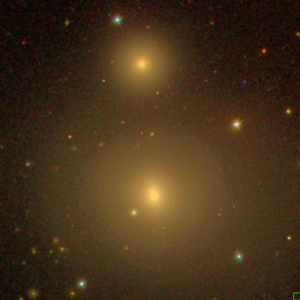NGC 508
| Galaxy NGC 508 |
|
|---|---|

|
|
| NGC 507 & NGC 508 (above) SDSS image | |
| AladinLite | |
| Constellation | fishes |
|
Position equinox : J2000.0 , epoch : J2000.0 |
|
| Right ascension | 01 h 23 m 40.6 s |
| declination | + 33 ° 16 ′ 49 ″ |
| Appearance | |
| Morphological type | E0: |
| Brightness (visual) | 13.1 mag |
| Brightness (B-band) | 14.1 mag |
| Angular expansion | 1.1 ′ × 1.1 ′ |
| Surface brightness | 13.4 mag / arcmin² |
| Physical data | |
| Affiliation |
NGC-507 Group WBL 38 |
| Redshift | 0.018433 ± 0.000040 |
| Radial velocity | 5526 ± 12 km / s |
|
Stroke distance v rad / H 0 |
(253 ± 18) x 10 6 ly (77.7 ± 5.4) Mpc |
| history | |
| discovery | Wilhelm Herschel |
| Discovery date | September 12, 1784 |
| Catalog names | |
| NGC 508 • UGC 939 • PGC 5099 • CGCG 502-068 • MCG + 05-04-045 • 2MASX J01234058 + 3316502 • Arp 229 • VV 207b • GC 295 • H III 160 • h 109 • GALEX ASC J012340.57 + 331650.6 • LDCE 74 NED072 | |
NGC 508 is an elliptical galaxy from the Hubble type E0 in the constellation fish on the ecliptic . It is estimated to be 253 million light years from the Milky Way and about 80,000 light years in diameter. Together with NGC 507 , it forms the galaxy pair ARP 229 .
In the same area of the sky are u. a. the galaxies NGC 503 , NGC 504 , NGC 507 , IC 1687 .
The object was discovered on September 12, 1784 by the German-British astronomer Wilhelm Herschel .
Web links
Commons : NGC 508 - collection of images, videos, and audio files
